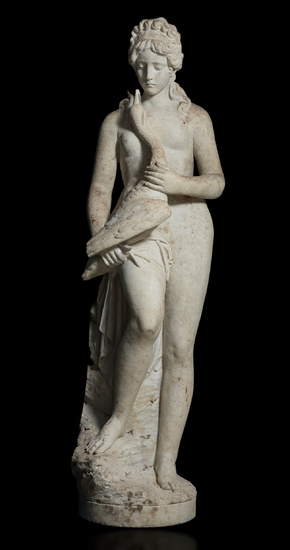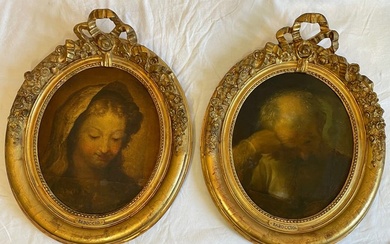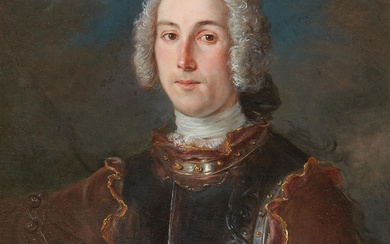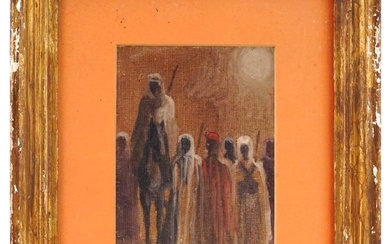Italian or French school; end of the 18th century - beginning of the 19th century
Italian or French school; late 18th - early 19th century.
"Leda and the swan".
Carved stone.
Measurements: 170 x 44 x 46 cm.
Carved sculpture showing a young woman standing and holding a film resting on her hip. The way in which the young woman leans her face downwards and the way in which the swan raises its neck, trying to touch the young woman's face with its beak indicates an attitude of intimacy between both of them in such a way that the representation draws from classical sources, specifically from the story of Leda and the swan. The work stands out for the delicacy of the carving, which is evident in details such as the animal's plumage or the curls of the protagonist. In addition, the young woman, who is almost naked, has a cloth on the lower part of her body which is stuck to her body in the manner of the wet cloth technique, thus showing great technical quality in the creation of this work.
The classical myth tells how Zeus, transformed into a swan, takes advantage of Leda's sleep to kiss her. The story of Leda and the swan is a story that has been widely represented throughout the history of Western art, and has its origins in Greek mythology. Zeus, the Roman Jupiter, came down from Olympus in the form of a swan to meet Leda, daughter of Testius and wife of King Tindarus of Sparta, as she was walking. As a result of this encounter, Leda laid two eggs, from which four children were born, two sets of twins: Helen and Pollux (immortals, children of Zeus) and Clytemnestra and Castor (mortals, children of Tindarus). Castor and Pollux, however, are considered to be twins, and are known as the Dioscuri.
HELP
View it on
Sale price
Estimate
Time
Auction House
Italian or French school; late 18th - early 19th century.
"Leda and the swan".
Carved stone.
Measurements: 170 x 44 x 46 cm.
Carved sculpture showing a young woman standing and holding a film resting on her hip. The way in which the young woman leans her face downwards and the way in which the swan raises its neck, trying to touch the young woman's face with its beak indicates an attitude of intimacy between both of them in such a way that the representation draws from classical sources, specifically from the story of Leda and the swan. The work stands out for the delicacy of the carving, which is evident in details such as the animal's plumage or the curls of the protagonist. In addition, the young woman, who is almost naked, has a cloth on the lower part of her body which is stuck to her body in the manner of the wet cloth technique, thus showing great technical quality in the creation of this work.
The classical myth tells how Zeus, transformed into a swan, takes advantage of Leda's sleep to kiss her. The story of Leda and the swan is a story that has been widely represented throughout the history of Western art, and has its origins in Greek mythology. Zeus, the Roman Jupiter, came down from Olympus in the form of a swan to meet Leda, daughter of Testius and wife of King Tindarus of Sparta, as she was walking. As a result of this encounter, Leda laid two eggs, from which four children were born, two sets of twins: Helen and Pollux (immortals, children of Zeus) and Clytemnestra and Castor (mortals, children of Tindarus). Castor and Pollux, however, are considered to be twins, and are known as the Dioscuri.
HELP







